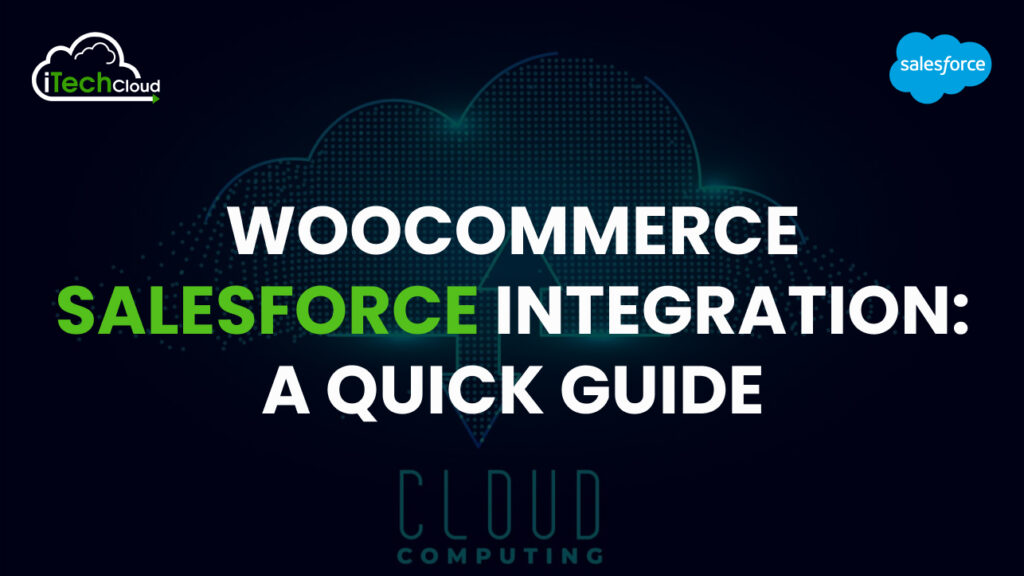WooCommerce Salesforce Integration: A Quick Guide

The integration of WooCommerce with Salesforce can transform how businesses manage their eCommerce operations and customer relationships. Combining WooCommerce’s robust online store functionalities with Salesforce’s powerful CRM capabilities enables businesses to streamline workflows, automate processes, and enhance customer experiences. This guide provides an in-depth look at WooCommerce Salesforce integration, including its benefits, methods, and best practices.
Table of Contents
What is WooCommerce Salesforce Integration?
WooCommerce Salesforce Integration connects the WooCommerce platform with Salesforce CRM, enabling seamless data synchronization. It automates the transfer of customer details, orders, and product information, enhancing sales and marketing efficiency. This integration ensures real-time updates, streamlines inventory management, and improves customer relationship management by providing a unified view of data. Businesses benefit from better insights, automated workflows, and enhanced customer engagement, leading to improved operational efficiency and increased sales.
Why Integrate WooCommerce with Salesforce?
1. Centralized Data Management:
Integrating WooCommerce with Salesforce enables businesses to sync customer data, order details, and inventory information in real-time. This centralized approach eliminates data silos and ensures consistency across platforms.
2. Customer Insights:
Salesforce’s advanced analytics and reporting tools allow businesses to gain deeper insights into customer behavior, purchase history, and preferences. This data can inform personalized marketing strategies.
3. Improved Marketing Efficiency:
With integration, marketers can automate campaigns, track performance metrics, and retarget customers more effectively. Salesforce marketing tools, combined with WooCommerce’s sales data, make campaign optimization seamless.
4. Streamlined Operations:
Manual data entry is time-consuming and prone to errors. Integration automates data synchronization, reducing the workload for teams and improving accuracy.
5. Better Customer Support:
By having a complete view of customer interactions and purchase history, support teams can deliver personalized and timely assistance, enhancing customer satisfaction.
Key Features of WooCommerce Salesforce Integration
WooCommerce Salesforce Integration empowers businesses to streamline operations, boost efficiency, and enhance customer experiences by connecting their WooCommerce store with Salesforce CRM. Here are the key features that make this integration invaluable:
1. Real-Time Data Synchronization
Seamlessly sync customer information, orders, and product details between WooCommerce and Salesforce in real time. This ensures your data is always accurate and up-to-date, eliminating manual data entry and reducing errors.
2. Custom Field Mapping
Map WooCommerce fields to Salesforce custom objects and fields to match your unique business processes. This feature offers flexibility, allowing tailored data flows that suit your specific operational needs.
3. Automated Workflows
Streamline tasks with automation, such as creating leads, updating orders, and managing customer status. This reduces manual intervention and accelerates business processes, saving time and effort.
4. Inventory Management
Keep your inventory levels in sync across platforms. With real-time stock updates, businesses can avoid over-selling or stockouts, ensuring a smooth shopping experience for customers.
5. Advanced Reporting and Analytics
Salesforce’s robust analytics tools to gain actionable insights into sales trends, customer behavior, and product performance. Make data-driven decisions to grow your business.
6. Customer Segmentation and Targeted Marketing
Segment customers based on purchase history, order value, and behavior. Use this data to create personalized marketing campaigns, increasing customer engagement and driving repeat business.
7. Customizable Sync Rules
Define rules to sync only specific data, such as certain product categories, order statuses, or customer groups. This helps businesses manage their data efficiently and prioritize essential information.
8. Two-Way Data Sync
Enable bidirectional data updates, ensuring any changes in WooCommerce or Salesforce are reflected instantly in the other system. This ensures data consistency across platforms.
9. Multi-Store Support
Manage multiple WooCommerce stores within a single Salesforce instance. This feature is ideal for businesses with diverse online stores, simplifying operations and centralizing data management.
10. Customer Support
With unified customer data, support teams can access detailed customer profiles and order histories, enabling them to deliver faster and more personalized support.
11. Improved Scalability
The integration adapts to your needs, allowing you to manage increasing data volumes and complex workflows without compromising efficiency.
Methods for WooCommerce Salesforce Integration
Integrating WooCommerce with Salesforce can be achieved using various methods, each catering to different business needs, technical capabilities, and budgets. Below are the most popular methods:
1. Using Third-Party Integration Tools
Several third-party tools simplify the integration process by offering pre-built connectors. These tools are ideal for businesses seeking quick and hassle-free integration.
- Popular Tools: Zapier, Automate.io, Skyvia, or PieSync.
- Features: Real-time sync, drag-and-drop configuration, and pre-configured templates for syncing customer data, orders, and products.
- Ease of Use: User-friendly interfaces make these tools accessible to non-developers.
2. WooCommerce Plugins for Salesforce Integration
WooCommerce-specific plugins provide dedicated integration capabilities tailored for Salesforce.
- Popular Plugins: WooCommerce Salesforce Integration Connector, WP Fusion, or CRM Perks.
- Features: Seamless syncing of orders, contacts, and leads; field mapping; and support for automating workflows.
- Ease of Use: Easy to install and configure within WooCommerce, often with a one-time setup process.
3. Custom API Integration
For businesses with specific requirements, custom API integration offers a tailored solution.
- Approach: Developers use WooCommerce REST API and Salesforce APIs to create a custom integration.
- Features: Complete control over data flow, customized workflows, and scalability.
- Use Case: Suitable for businesses with unique processes or high data complexity.
- Technical Requirement: Requires experienced developers familiar with both platforms’ APIs.
4. Middleware Platforms
Middleware platforms act as intermediaries to connect WooCommerce and Salesforce.
- Popular Platforms: MuleSoft, Dell Boomi, or Jitterbit.
- Features: Advanced data transformation, scalability, and robust workflow management.
- Use Case: Ideal for enterprises handling large volumes of data and requiring sophisticated integrations.
5. Manual Data Export and Import
For small-scale businesses, data can be manually exported from WooCommerce and imported into Salesforce using CSV files.
- Features: No additional tools required; involves exporting customer and order data from WooCommerce and uploading it to Salesforce.
- Limitations: Time-consuming and prone to errors; not suitable for real-time updates.
Best Practices for WooCommerce Salesforce Integration
Integrating WooCommerce with Salesforce enhances customer management, streamlines processes, and boosts sales efficiency. To ensure a seamless integration, follow these best practices:
1. Define Integration Objectives
Clearly outline your integration goals, such as syncing customer data, managing orders, or automating marketing efforts. Align these objectives with your business needs to maximize ROI.
2. Choose the Right Integration Tool
Select a reliable integration platform like Zapier, Mulesoft, or native WooCommerce Salesforce plugins. Evaluate features, compatibility, and support to find a tool that meets your requirements.
3. Map Data Fields
Identify and map the key data fields between WooCommerce and Salesforce. For instance, sync order details, customer profiles, and payment information to avoid discrepancies and ensure data accuracy.
4. Automate Key Processes
Set up automation for recurring tasks, such as updating inventory, creating customer records, and generating reports. Automation reduces manual errors and enhances efficiency.
5. Ensure Data Security
Protect sensitive customer data during integration. Use secure APIs, implement encryption, and comply with GDPR or other relevant regulations to build customer trust.
6. Test the Integration
Thoroughly test the integration in a staging environment before going live. Verify data syncing, workflow automations, and compatibility to address potential issues early.
7. Real-Time Syncing
Real-time syncing ensures that updates in WooCommerce, such as new orders or customer details, are immediately reflected in Salesforce. This enhances customer support and marketing efficiency.
8. Salesforce Features
Maximize Salesforce capabilities by using its features like Customer 360, reporting, and analytics to gain deeper insights into your WooCommerce data.
9. Monitor and Optimize Performance
Regularly monitor the integration’s performance. Track metrics like syncing errors, processing times, and data accuracy. Make necessary adjustments to optimize workflows.
10. Provide Staff Training
Train your team to use the integrated systems effectively. Ensure they understand the workflows and can address any issues promptly.
Benefits of WooCommerce Salesforce Integration
WooCommerce-Salesforce integration offers a variety of benefits that can enhance the operational efficiency and customer experience of an e-commerce business. By linking WooCommerce, a popular WordPress-based online store plugin, with Salesforce, a leading Customer Relationship Management (CRM) platform, businesses can streamline their processes and boost overall performance. Here’s a summary of the key benefits:
1. Improved Data Synchronization
Integrating WooCommerce with Salesforce ensures that customer, order, and product data are seamlessly synchronized across both platforms. This means that as a customer places an order in WooCommerce, the details are automatically transferred to Salesforce. This real-time data flow eliminates the need for manual data entry, reducing human error and saving time.
2. Customer Insights
Salesforce provides robust CRM tools to analyze and segment customer data. When integrated with WooCommerce, businesses gain a deeper understanding of their customers’ purchasing behaviors, preferences, and order history. This information allows businesses to create targeted marketing campaigns, personalized recommendations, and better customer support, driving sales and improving customer satisfaction.
3. Streamlined Order Management
The integration simplifies the order management process by consolidating data from both platforms. Customer orders, payments, and shipping information are automatically updated in Salesforce, allowing businesses to track orders efficiently. This centralization reduces the complexity of managing separate systems, improving operational efficiency.
4. Effective Marketing Automation
With the integration, businesses can leverage Salesforce’s marketing automation tools. They can set up email campaigns, promotional offers, and loyalty programs based on WooCommerce data, such as abandoned cart recovery, product recommendations, and purchase history. Automating these processes enhances customer engagement, increases conversion rates, and boosts sales.
5. Better Inventory Management
Salesforce’s reporting capabilities, combined with WooCommerce’s product management features, can help businesses better track and manage their inventory. Real-time updates on stock levels and sales data enable proactive inventory management, preventing stockouts or overstocking.
6. Scalability and Growth
Maintaining separate systems for e-commerce and CRM becomes inefficient. The WooCommerce-Salesforce integration provides scalability by consolidating workflows, enabling businesses to handle higher volumes of data, orders, and customers without sacrificing efficiency.
7. Seamless Customer Service
Integration helps customer service teams by providing a 360-degree view of customer interactions. Support teams can access complete order history and customer profiles, allowing them to resolve issues quickly and offer a more personalized service.
Conclusion:
Integrating WooCommerce with Salesforce can significantly enhance your business operations by streamlining data flow between your online store and CRM system. This integration helps automate order management, customer data syncing, and inventory control, leading to improved efficiency and reduced manual tasks. By unifying your sales, marketing, and customer service efforts, you gain valuable insights that drive better decision-making and customer experiences.

